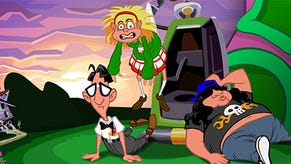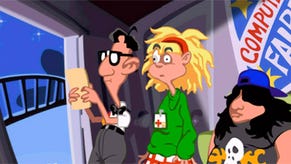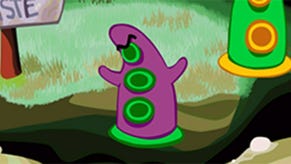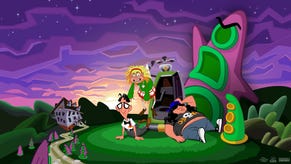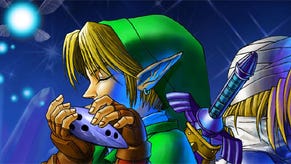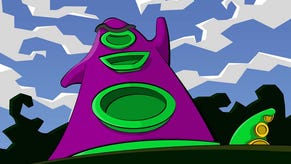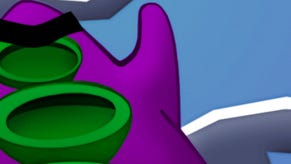Behind the Art of Day of the Tentacle
COVER STORY: LucasArts alumni Peter Chan and Larry Ahern chat about the challenges of making a "cartoon adventure" under the constraints of early '90s technology.
This article first appeared on USgamer, a partner publication of VG247. Some content, such as this article, has been migrated to VG247 for posterity after USgamer's closure - but it has not been edited or further vetted by the VG247 team.
[Editor's note: What follows is one of three articles about the making of Day of the Tentacle, written in accordance with the release of its Remastered version. For more about the design of Day of the Tentacle, click here, and for more about the game's music, click here.]
If you look at the cultural landscape of 1993, the cartoony nature of LucasArts' Day of the Tentacle should make perfect sense.
Of course, the creative minds behind Maniac Mansion's sequel clearly drew from the cartoons of their childhoods (or, more accurately, their parents' childhoods), but during the time of DoTT's production, American animation found itself in a short-lived Renaissance of sorts. In a movement spurred on by pioneers like Ralph Bakshi, Steven Spielberg, and The Walt Disney Company, the crass, cheaply made TV cartoons of the '80s and earlier slowly transitioned into high-quality productions meant to achieve more than selling toys. Animated programs like Tiny Toon Adventures, Animaniacs and The Ren & Stimpy Show existed as expensive throwbacks to the golden age of cinematic cartoons, making good animation en vogue again after decades of ignominy.

This period of newfound relevance birthed Day of the Tentacle, an adventure game which aspired to capture the same spirit as classic, cinematic cartoons—despite the constraints of an extremely low resolution and five floppy discs. To find out how the adventure game masterminds at LucasArts pulled off such a nearly impossible feat—and brought this classic adventure game to a new age via the Remastered version—I recently interviewed Day of the Tentacle lead artist Peter Chan, as well as lead animator, Larry Ahern. Read on, and be sure to check out the other portions of this retrospective for everything you've ever wanted to know about Day of the Tentacle.
Starting at LucasArts
While Chan and Ahern were no strangers to the LucasArts process—having both worked on Monkey Island 2: LeChuck's Revenge—the sheer ambition of Day of the Tentacle made for a real learning experience, with increased responsibilities and new challenges for the two artists.
Larry Ahern: The first project I worked on when I got [to LucasArts]... I was hired in 1990, and I was really interested in the comedy games, and then, they went around and asked all the new people, “What would you like to work on?” And they were about to do the sequel to Monkey Island, and I said, “I want to do that.” And they said, “OK, great, but you're the new guy, so you're going to work on The Dig.” So, I ended up on that. [Editor's Note: The Dig went through various revisions and would eventually see a release in 1995.]

Peter Chan: I was in-house [at LucasArts] for three games, I think. I made a bunch of games, but, the adventure games were pretty much Monkey Island, Day of the Tentacle and Full Throttle. Was there another in there? I think that was it. And then, see, the reason why my name is on other games was just because I always brought my lunch to work, so, during my lunch break, I would just walk around and ask if anyone needed any help.
LA: [The Dig] ended up getting shelved about six months in, and I got to switch to working on Monkey Island 2 midstream. At that point I was working with Tim [Schafer] and Dave [Grossman], and I guess Ron Gilbert was the project leader. He would come and give the animators a list of things to animate. “Give me a Guybrush picking this thing up, or leaning down, or falling down,” or whatever. And he wouldn't give any context for it. And I tried asking questions about it, and he said, “Just do this, this, this, and this, laundry list, check it off,” and I got real frustrated with that. So, I started wandering over to Tim and Dave's office, and saying, “Hey, so, what do you need this for, what's happening,” and then they'd describe the scene for me, and I'd say, “Oh, well, wouldn't it be more fun if I did it this way,” and they'd go, “Yeah, that'd be even better. Go do that.” And I'm like, “OK, can you get it approved with Ron, then?” “Oh, don't worry, we'll take care of that.”
PC: [LucasArts] was small, in comparison to nowadays. Yes, it was very, very small. I mean, Ron and Tim, they were the project leads, so basically, I always had to get their approvals, but yes, there were opportunities for collaboration, and for me to design something that wasn't exactly in the document. Back then, I don't think we really had art directors or production designers. Those were usually titles for film. And then, for us, I think because it was so new, lead artist just meant the guy who was stuck doing most of the art.

LA: So then, when it was time to do the next project, and they started on Day of the Tentacle, [Tim and Dave] had been working with Ron and Gary Winnick, who had done the original Maniac Mansion, working with them on concepts and stuff, and then they started pulling a team together, and I wanted to be involved with that. I had done a lot of cartooning in the past, so I wanted to do character designs. And then Peter Chan was going to be the background artist, so he and I got to work together and figure out a look for the whole thing.
PC: Luckily, I had [Sam & Max creator Steve Purcell] there during Monkey Island 2, but after Monkey 2, then I was given the opportunity to work on adventure games with Tim, and that's when I started to get really scared and nervous and insecure. Because now I'm given this role to come up with something brand new, because, when I came on to work on Monkey 2, basically, they told me the art style, it was established already. So, the art style was, let's say, the Disney film, Pinocchio. So, it was like, okay, I can kind of mimic that, so that was easy, because someone already came up with that idea. So, for me to try to figure out what Day of the Tentacle was going to look like was, at first, a great opportunity, but, sometimes, it's too wide open. You kind of have to figure out, okay, what's the best style for this wacky game?

